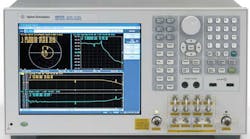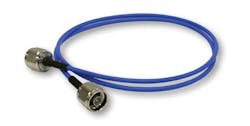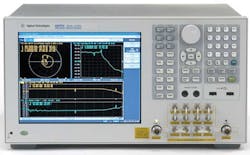Intermodulation distortion (IMD) indicates the nonlinear behavior of different RF/microwave devices and components. IMD occurs when two or more signals occupy the same transmission path and the signals mix, creating additional signals. The added signals can disrupt a system’s performance, for example, by limiting the sensitivity of a high-frequency receiver. IMD can take place in active components, such as amplifiers, as well as in passive components like cables and connectors.
This file type includes high resolution graphics and schematics when applicable.
In recent years, passive components have been given their own IMD category, commonly known as passive intermodulation (PIM). Understanding the causes for IMD and PIM, and how to measure the amplitude levels of these types of distortion, can become positive steps toward minimizing or eliminating IMD and PIM from high-frequency designs.
Ideally, an active or passive component would provide the same signal quality at both its output port (albeit at a different amplitude) and input port. Unfortunately, nonlinear effects contribute to the creation of additional, harmonically related signal content when multiple signals mix, and these additional signals can be a concern when they create noise levels above the sensitivity of a communications system’s receiver.
A number of factors can contribute to IMD and PIM, including the composition of conductors and rough edges on conductive contacts in components. High levels of ferromagnetic materials, such as nickel, can yield nonlinear voltage effects and distortion in conductors, and higher power levels can also raise the noise levels produced by IMD and PIM. IMD is typically not a concern at lower power levels, since effective filtering can minimize the effects from the additional signal content.
PIM refers to the nonlinear distortion effects that can take place in passive components, such as cables and connectors, power combiners/dividers, and antennas. The distortion results from mixing of two or more tones, including even-order and odd-order tones. Typically, third-order nonlinear effects stem from the mixing of the harmonic and fundamental tones of two signals, f1 and f2, such as the difference of second-harmonic and fundamental tones: 2f1 – f2 or 2f2 – f1.
As with IMD, PIM may be caused by the ferromagnetic material content of a component, the use of dissimilar metals in a conductive path, poor conductor contact junctions, and even poor contact pressure in connectors. Dirt can play a major role in the generation of PIM, in terms of contaminated conductor contact surfaces. Poor crimping on cables and connectors can create multiple contact points with air gaps that elevate PIM levels. PIM often changes over time as components age and change with corrosion, and due to the diminishing quality of the electrical contact points.
Simple remedies to PIM include maintaining clean contact points; avoiding the use of dissimilar metals in conductive paths; and utilizing conductive paths that are machined to tight tolerances to minimize air gaps in the electrical contact points of RF/microwave components. A thorough introduction to IMD, as it occurs in coaxial connectors, comes by way of RF Connectors, a division of RF Industries, in a six-page application note titled “Intermodulation Distortion in RF Connectors.”
Ironically, when preparing to measure IMD or PIM on components such as antennas or cables, it’s often necessary to equip a test system with jumper cables that have low PIM distortion. A number of suppliers offer low-PIM cable assemblies that have been carefully tested and validated to perform within tight tolerances. For example, the JA and JB series cables (Fig. 1) from Microlab, which come with different connectors, are designed for use from dc to 6 GHz with PIM performance of better than –153 dBc at 1800 MHz. PIM performance, when tested with two tones at +43 dBm, is typically better than –158 dBc. The cables include tri-metal plated connectors built to MIL-C-39012 specifications.
Measuring Distortion
Creating a measurement system to evaluate a device under test (DUT) for IMD and PIM involves at least two signal sources: a power combiner to feed the signals to the DUT; and some form of test receiver or analyzer to examine the results of the combined signals at the DUT’s output. Isolators between the generators and the power combiner can help keep the test tones clean.
The traditional test receiver for IMD and PIM measurements is the spectrum analyzer, although more dedicated test instruments have emerged in recent years, such as the PIM Master model MW82119B analyzer from Anritsu Co. The portable, battery-powered instrument contains signal sources and a receiver, and is available for applications at different frequencies from 2 MHz to 3 GHz, including for testing PIM in components for LTE 800-MHz, UMTS 2100-MHz, and LTE 2600-MHz systems.
The MW82119B (Fig. 2) can analyze third-, fifth-, and seventh-order IMD and PIM products (an additional option enables second-order IMD measurements). It can also function as a cable and antenna analyzer (with the Site Master option) for swept measurements from 2 MHz to 3 GHz. The analyzer’s measurements include PIM, distance to PIM, and noise floor, while cable and antenna measurements include cable loss, distance to fault, return loss, and VSWR. The analyzer, which can measure PIM versus time, will run for more than three hours on (rechargeable) battery power. This example of portable measurement equipment offers an alternative to a spectrum analyzer, with its ability to perform on-site testing of IMD and PIM.
Perhaps representative of the trend to add more measurement capabilities to existing test products, the same company recently introduced options for IMD measurements in a pair of its VectorStar vector network analyzers (VNAs). Since independent control of multiple test signal sources is required to perform IMD or PIM measurements, the options allow measurements of harmonics, spurious products, and IMD using a frequency-offset function to create two precisely spaced test tones. In addition, the firm introduced IMDView software to simplify IMD measurements with the VNAs.
Similarly, Keysight Technologies simplifies PIM measurements with its desktop E5072A ENA Series VNAs (Fig. 3), which actually combine PIM testing with S-parameter measurements. The combination is meant to replace conventional PIM measurements and enable fast swept-frequency PIM measurements across wide bandwidths. These rack-mount analyzers are available for use from 30 kHz to 4.5 GHz or 30 kHz to 8.5 GHz. They are complete systems, with multiple test-signal sources and VNA receivers. They use a frequency-offset mode option to create the required multitone test signals, and can make measurements with fixed test tones and swept-frequency test signals, as well as in a PIM spectrum mode that permits simultaneous viewing of third-, fifth-, and seventh-order IMD products.
These instruments are just two examples of the many measurement solutions currently available as dedicated instruments or as add-on options for performing IMD and PIM measurements. Other examples include the iPA series of portable battery-powered PIM testers from Kaelus with application-specific transmit and receive frequencies (such as for LTE 800 and LTE 2600 testing), and the portable PIM 21 series of test sets from Boonton of the Wireless Telecom Group. These testers, which show PIM levels from –80 to –153 dBc at 850 MHz, can be ordered with two CW carrier frequencies between 800 and 2200 MHz.
This file type includes high resolution graphics and schematics when applicable.




